Budget Variance Analysis Programs Starting September 2025
We've been running these courses since 2019, and honestly, the format we've settled on works. Not because it's fancy—because it actually helps people understand the practical side of variance analysis beyond spreadsheet formulas.
Our next intake begins in six months, giving you plenty of time to sort out schedules and figure out if this fits your professional development goals.
Professional Development Courses
Professionals Trained Since 2019
Would Recommend to Colleagues
Weeks Flexible Learning
What Makes Our Approach Different
Real Financial Data
We use anonymised datasets from actual Australian businesses. You'll work through scenarios that mirror what finance teams deal with daily—not textbook examples that skip the messy parts.
Flexible Evening Format
Tuesday and Thursday evenings, 6:30 PM to 8:30 PM. We get it—most participants are working full-time. Sessions are recorded, and we build in catch-up weeks because life happens.
Industry Practitioners
Our instructors currently work in finance roles. They're teaching you methods they actually use, not theory that looked good ten years ago. Their day jobs inform what they share.
Peer Discussion Groups
Small cohorts mean genuine discussion. You'll hear how others approach variance problems, which often teaches you more than following a single methodology would.
Portfolio Building
By week twelve, you'll have completed variance analyses you can reference in interviews or performance reviews. Tangible work that demonstrates capability, not just a certificate.
Post-Course Support
Access to our alumni community and quarterly refresher sessions for a year after completion. Questions come up when you apply this stuff at work—we stick around to help.


Learn From People Who Do This Work
Tomas Lundberg leads our foundational courses. He's currently senior financial analyst at a mid-size manufacturing firm and has been teaching variance analysis since 2021. Before that, ten years in corporate finance roles across Sydney and Melbourne.
Petra Koskinen handles the advanced modules. She works as finance manager for a retail group and specialises in seasonal variance challenges. Her approach is blunt and practical—she'll tell you when a technique sounds good but doesn't work in actual business environments.
Both bring case studies from their current roles (with identifying details changed, obviously). That immediacy matters. You're learning approaches that solved problems last quarter, not last decade.
Read Full Instructor ProfilesUpcoming Course Schedule
All courses run for twelve weeks with online sessions and self-paced components. We limit cohorts to 18 participants to maintain discussion quality.

Budget Variance Fundamentals
Start with the basics—how to identify variances, calculate them correctly, and explain what they mean. You'll work through monthly close scenarios and build reporting templates you can actually use at work. Assumes you're comfortable with Excel but doesn't require advanced finance knowledge.
Express Interest →
Advanced Variance Analysis and Forecasting
For those already doing variance work who want to dig deeper. Covers rolling forecasts, variance drivers, seasonality adjustments, and how to present complex variance stories to non-finance stakeholders. Prerequisite: two years working with budgets or completion of our fundamentals course.
Express Interest →What Past Participants Say
"I'd been doing budget reports for three years but never really understood why certain variances mattered more than others. The course changed how I think about the numbers—now I can actually explain variance patterns to my manager instead of just presenting spreadsheets."
Financial Analyst, Healthcare Services
